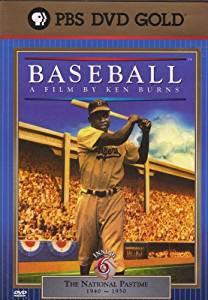The Sixth Inning of Baseball: A Film by Ken Burns explores the national pastime during the 1940s, which was quite the tumultuous decade in American history. It was a decade of war as the United States recovered from the Great Depression and found itself in a position of having to enter World War II. It was also the decade of Ted Williams and Joe DiMaggio, of  women’s professional baseball, and of Jackie Robinson.
women’s professional baseball, and of Jackie Robinson.
In a chronological sense, the Sixth Inning was an easier one to follow along with than any of the Innings that preceded it. The first part of this disc was dominated by two of the game’s greatest hitters. 1941 was the summer of Joe DiMaggio and Ted Williams, whose hitting performances captivated the baseball world. Joe DiMaggio’s fifty-six game hitting streak and Ted Williams’s .406 season average have both remained unmatched ever since.
The 1941 World Series resulted in a devastating loss for the Brooklyn Dodgers to the New York Yankees. At the end of the season, Dodgers general manager Larry MacPhail , drunk and belligerent, threatened to sell off all his players. The Dodgers instead opted to let go of MacPhail and brought in Branch Rickey, thus setting the stage for the breaking of the color barrier in the coming years.
When the United States entered the war, Franklin Roosevelt insisted that baseball ought to continue. The country would be working longer and harder, and thus recreation became more important than ever, he said. However, this didn’t shield players from the draft, and baseball still suffered as a result. Players like DiMaggio and Bob Feller joined the war effort. Meanwhile, baseball turned to signing players (and umpires) who didn’t meet the usual caliber of play just to keep going.
As the war also drew away a number of minor leaguers, Philip Wrigley came up with the idea of starting a women’s professional baseball league in order to fill the baseball void as minor league teams fell apart. Women from all over, particularly softball players, were recruited. They had to be able to play ball, but they were also required to remain unequivocally feminine. Off the field, any time they were in public, they were required to be in skirts, heels, and makeup — a requirement that I, for one, would find very difficult to swallow.
Following the war, the disc goes into the story of Branch Rickey and Jackie Robinson. The story from Rickey’s time coaching at Ohio Wesleyan University, checking into a hotel in South Bend, Indiana to play Notre Dame, is absolutely heartbreaking, and certainly explains a lot regarding his determination to integrate baseball.
Branch Rickey certainly did his homework when choosing a player to break the color barrier, and clearly, he choose well. Promising not to retaliate and turn the other cheek for three years (three years!), Jackie Robinson signed with the Montreal Royals.
Burns breaks from the Jackie Robinson saga long enough to cover the 1946 World Series between the St. Louis Cardinals and the Boston Red Sox. Though the Sox were the heavy favorites to win, the Cards employed the “Williams shift” to prevent Ted Williams from having much success at the plate. Thanks in part to this strategy, the Cardinals won that year’s Series. Roger Angell says it well when he explains that baseball is not a game about winning, like we think it is, but rather, it is a game about losing.
Jackie Robinson’s debut with the Brooklyn Dodgers in 1947 was certainly an event, one that we continue to celebrate today. As expected, he endured an endless stream of taunts, threats, and even attempts at actual bodily harm. Through it all, he bit his tongue. Instead, he let his performance on the field speak for him. Not only was he named Rookie of the Year at the end of the season, he was also determined to be the second most popular man in America, after Bing Crosby. Robinson’s efforts eventually allowed other black players, including the great pitcher Satchel Paige, to break into the majors as well.
Ken Burns does a good job of pointing out that, for all the virtues that surrounded Robinson’s trek into Major League Baseball, it was a devastating event for the Negro Leagues. The Brooklyn Dodgers became the team of black America, and attendance at Negro Leagues games declined. As we know now, the Negro Leagues would eventually meet its end as a result.
The disc ends with the death of Babe Ruth in 1948. It’s only appropriate that the Sultan of Swat would receive this kind of nod (and convenient that he would die at the end of a decade — not to be morbid or anything). Burns never touches on what Ruth thought of Jackie Robinson, nor on what Robinson thought of Ruth. Perhaps nobody knows. But as Buck O’Neil points out, both men were giants in the game. Each of them, in their own way, changed baseball forever.




